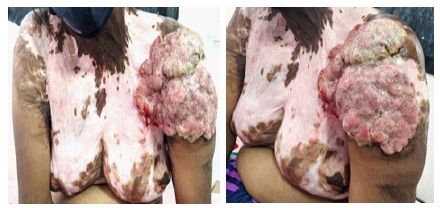
Journal of Clinical Images and Medical Case Reports
ISSN 2766-7820
Clinical Image - Open Access, Volume 3
Marjolin’s ulcer
Abhay K Kattepur*; Aswathappa D
Department of Surgical Oncology, Sri Devaraj Urs Academy of Higher Education and Research, Tamaka, Kolar, Karnataka, India.
*Corresponding Author: Abhay K Kattepur
Assistant Professor, Department of Surgical Oncology, Sri Devaraj Urs Academy of Higher Education
and Research, Tamaka, Kolar- 563101, Karnataka,
India.
Email: drabhay1985@gmail.com
Received : Dec 14, 2021
Accepted : Jan 28, 2022
Published : Feb 04, 2022
Archived : www.jcimcr.org
Copyright : © Kattepur AK (2022).
Citation: Kattepur AK, Aswathappa D. Marjolin’s ulcer. J Clin Images Med Case Rep. 2022; 3(2): 1638.
Description
A 42-year-old lady presented with complaints of a slow growing fungating growth over the left shoulder of 3 months duration. This was associated with pain of 2 weeks duration and occasional sero-purulent discharge. Past history of burns to the upper torso, neck and back sustained 15 years ago was elicited. Physical examination revealed a large ulcero-proliferative growth involving the left shoulder and upper arm with areas of scarring and contractures adjacent to the lesion (Figure 1). There was no axillary adenopathy. Rest of the examination was unremarkable. Edge wedge biopsy revealed moderately differentiated squamous cell carcinoma. Computerized Tomogram (CT) of the thorax showed the tumor was infiltrating into the adjacent soft tissues, with no regional adenopathy or pulmonary metastases. The patient underwent wide local excision. Histopathological examination confirmed moderately differentiated squamous cell carcinoma with negative margins.
Marjolin’s ulcer or scar carcinoma arising in a burn scar or previously damaged skin was first described by Dr. Jean Nicolas Marjolinin 1828. Although the term has been specifically used for the development of squamous cell cancers in chronic burn scars, other tumors like basal cell cancers, melanomas etc. have also been added into the list. Marjolin’s ulcer is characterized by a locally aggressive growth pattern and high recurrence rate. The latent period from injury to development of malignancy is variable. The diagnosis is clinical and surgery forms the mainstay of management. Nodal involvement is rare, given that the dermal lymphatics are often damaged due to the prior burn injury or scarring. Higher recurrence rates, despite treatment contribute to the overall poor prognosis in these tumors.
References
- Xiang F, Song HP, Huang YS. Clinical features and treatment of 140 cases of Marjolin’s ulcer at a major burn center in southwest China. Exp Ther Med. 2019; 17: 3403-3410.
- Yu N, Long X, Lujan-Hernandez JR, Bai M, Wang Y, Wang X, et al. Marjolin’s ulcer: A preventable malignancy arising from scars. World J Surg Onc. 2013; 11: 313.

